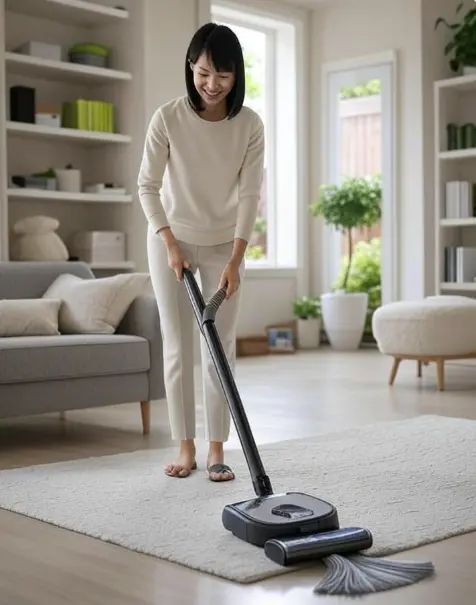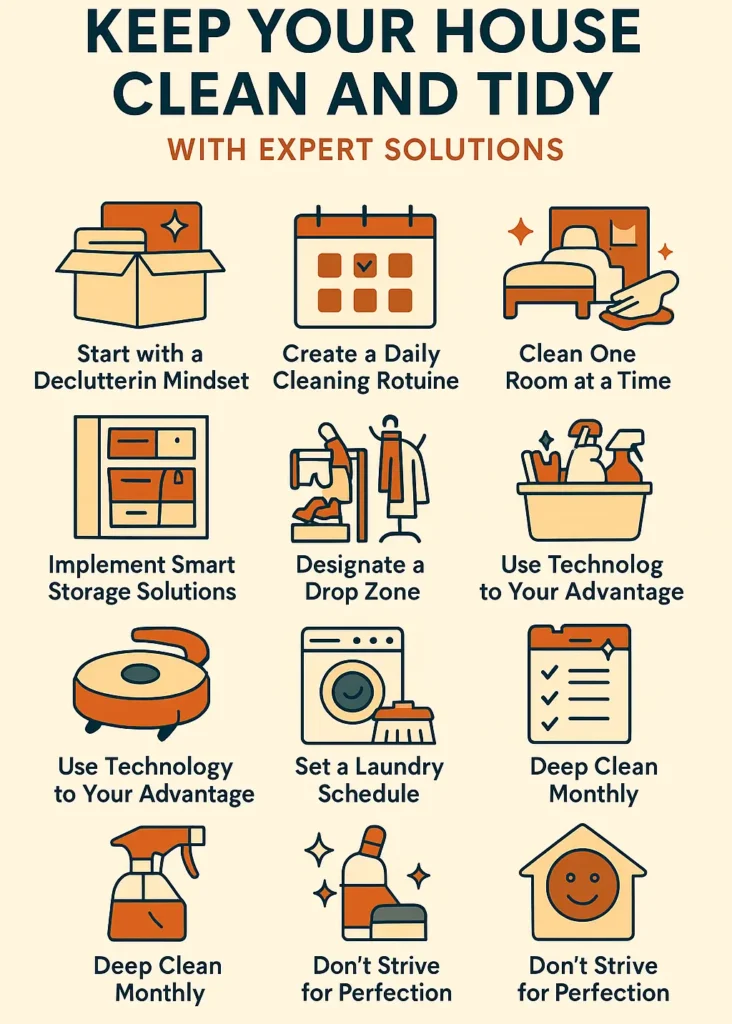Keeping home clean and organized can often feel like an endless battle, especially for those of us trying to juggle busy schedules, kids, pets, and a million daily tasks. But the good news is, creating a tidy living space doesn’t have to be a huge undertaking. With the right strategies and a few good habits, you can easily maintain a spotless environment.
A well-kept home not only looks great but also boosts your mental well-being, reduces stress, and creates a cozy atmosphere for both family and friends. While modern life can make cleanliness seem overwhelming, tips from home organization and cleaning experts can provide practical solutions to make the process easier. This article from Happy Birthday Wishes SMS shares simple, actionable advice to help you keep your home clean without sacrificing your time or peace of mind.

Tips To Keep Home Clean
1. Declutter Before You Clean
Before diving into cleaning, decluttering is the foundation of a tidy home. According to professional organizer Marie Kondo, a clutter-free space not only looks cleaner but also makes cleaning easier.
Peter Walsh, a renowned organization expert, also suggests assigning a place for every item. “If everything has a home, tidying becomes second nature,” he says. Use labeled storage bins or baskets to keep items organized.
How to Declutter Effectively:
Start Small: Tackle one area at a time, such as a drawer, a shelf, or a corner of a room. This prevents overwhelm and builds momentum.
Use the Four-Box Method: Label four boxes as “Keep,” “Donate,” “Trash,” and “Relocate.” Sort items accordingly to make decisions easier.
Ask the Right Questions: For each item, ask, “Do I use this regularly?” or “Does it bring me joy?” If the answer is no, consider letting it go.
Set a Timer: Dedicate 15-30 minutes daily to decluttering. Short, focused sessions are more sustainable than marathon cleanups.
2. Create a Cleaning Schedule
A structured cleaning schedule ensures no area of your home is neglected. Experts like Becky Rapinchuk, founder of Clean Mama, advocate for a weekly cleaning rhythm to spread tasks over time. He also suggests breaking tasks into daily 15-minute chunks to avoid burnout. Use a printable cleaning checklist to stay on track.
Sample Weekly Cleaning Schedule:
Monday: Dust surfaces and vacuum high-traffic areas.
Tuesday: Clean bathrooms (toilets, sinks, mirrors).
Wednesday: Wipe down kitchen appliances and counters.
Thursday: Mop hard floors and clean glass surfaces.
Friday: Wash bedding and towels.
Saturday: Tackle one deep-cleaning task (e.g., oven or fridge).
Sunday: Rest or catch up on small tasks.
3. Adopt the “One-Minute Rule”
The “One-Minute Rule,” popularized by Gretchen Rubin, author of The Happiness Project, is a game-changer for maintaining tidiness. If a task takes less than a minute to complete, do it immediately. Cleaning expert Melissa Maker recommends extending this to a “Five-Minute Tidy” at the end of each day. Spend five minutes tidying high-traffic areas like the living room or kitchen to reset your space. Examples include hanging up a coat, putting dishes in the dishwasher, or wiping down a countertop.
Why It Works:
Prevents small messes from piling up.
Builds consistent habits without requiring much effort.
Keeps surfaces clear, making deep cleaning easier.
4. Embrace the “Clean as You Go” Philosophy
Spills, crumbs, and messes become harder to clean if left for later. Hotel housekeeping professionals swear by “clean as you go” for efficiency and reduced effort.
Actionable Advice:
Wipe down kitchen counters immediately after cooking.
Rinse and load dishes instead of letting them pile up.
Squeegee the shower after each use to prevent buildup.
5. Master the Art of Surface Cleaning
Cluttered surfaces like countertops, coffee tables, and nightstands make a home feel chaotic. Keeping surfaces clear is a quick way to maintain tidiness.Lynsey Crombie, the “Queen of Clean,” recommends a 50/50 vinegar-water solution for streak-free cleaning of glass and stainless steel surfaces. Always test on a small area first.
Surface-Cleaning Hacks:
Use Baskets for Quick Pickups: Keep a basket in each room to toss stray items into for later sorting.
Implement a “No-Stack” Rule: Avoid piling papers or items on surfaces. File or recycle papers immediately.
Wipe as You Go: Keep microfiber cloths and a multipurpose cleaner handy for quick wipe-downs.
6. Streamline Laundry Routines
Laundry can quickly become a source of clutter if not managed properly. Experts suggest treating laundry as a daily or near-daily task rather than a weekend chore. Ann Russell, a cleaning influencer, advises setting a specific laundry day for bedding and towels to keep linens fresh and manageable.
Laundry Tips:
Do One Load a Day: Wash, dry, and fold one load daily to prevent piles from forming.
Use Sorting Hampers: Invest in a hamper with compartments for lights, darks, and delicates to save time.
Fold Immediately: Folding clothes right out of the dryer prevents wrinkles and reduces clutter.
7. Optimize Your Cleaning Tools
Having the right tools makes cleaning faster and more effective. Experts emphasize quality over quantity when it comes to cleaning supplies.Melissa Maker suggests investing in a high-quality vacuum with HEPA filters to trap dust and allergens, improving indoor air quality.
Must-Have Cleaning Tools:
Microfiber Cloths: Absorbent and reusable, perfect for dusting and wiping surfaces.
Cordless Vacuum: Lightweight and versatile for quick cleanups.
Multipurpose Cleaner: A non-toxic, all-in-one cleaner reduces the need for multiple products.
Squeegee: Ideal for streak-free windows and shower doors.
8. Use Storage Solutions Wisely
Smart storage is key to a tidy home. Professional organizers recommend maximizing vertical space and using multi-functional furniture. Marie Kondo advises folding clothes using her KonMari method to save space and make drawers visually appealing. Store clothes upright so you can see everything at a glance.
Storage Ideas:
Under-Bed Storage: Use flat bins for seasonal clothing or extra linens.
Wall Shelves: Install shelves for books, decor, or kitchen items to free up floor space.
Multi-Use Furniture: Opt for ottomans or coffee tables with hidden storage compartments.
9. Tackle High-Traffic Areas Daily
High-traffic areas like the kitchen, entryway, and living room tend to collect messes quickly. A daily maintenance routine keeps these spaces under control. Peter Walsh suggests creating a “launchpad” near the entryway with hooks, a shoe rack, and a tray for keys and mail to prevent clutter buildup.
Daily Tasks for High-Traffic Areas:
Kitchen: Wipe counters, clean the sink, and sweep the floor.
Entryway: Organize shoes, hang coats, and clear clutter from tables.
Living Room: Fluff pillows, fold blankets, and clear surfaces.
10. Incorporate Green Cleaning Solutions
Eco-friendly cleaning products are not only better for the environment but also safer for your family. Experts recommend simple, natural ingredients for effective cleaning. Becky Rapinchuk warns against mixing vinegar with bleach or hydrogen peroxide, as it can create harmful fumes. Always research DIY recipes for safety.
DIY Cleaning Recipes:
All-Purpose Cleaner: Mix 1 cup water, 1 cup white vinegar, and 10 drops of lemon essential oil.
Glass Cleaner: Combine 1/4 cup rubbing alcohol, 1/4 cup white vinegar, and 1/2 cup water.
Carpet Freshener: Sprinkle baking soda mixed with a few drops of essential oil, let sit for 15 minutes, then vacuum.
11. Involve the Whole Household
A tidy home is a team effort. Assign age-appropriate tasks to family members to share the workload and instill good habits. Lynsey Crombie suggests making cleaning fun by turning it into a game or setting a timer for a “cleaning sprint” to motivate everyone.
How to Delegate:
Kids: Have young children put away toys or dust low surfaces. Older kids can vacuum or take out the trash.
Roommates or Partners: Divide tasks based on preferences (e.g., one person handles dishes, another vacuums).
Use Chore Charts: Create a visual chart to track responsibilities and ensure accountability.
12. Maintain Your Cleaning Routine with Technology
Technology can simplify cleaning and organization. Apps and smart devices can help you stay on track. Melissa Maker recommends syncing cleaning reminders with your phone’s calendar to ensure consistency.
Useful Tools:
Cleaning Apps: Apps like Tody or Clean My House allow you to create custom cleaning schedules and set reminders.
Smart Vacuums: Robot vacuums like Roomba can handle daily floor cleaning, saving time.
Smart Planners: Use digital planners like Google Calendar to schedule deep-cleaning tasks.
13. Prevent Messes Before They Start
Prevention is the ultimate time-saver. Experts emphasize proactive habits to minimize messes. Ann Russell suggests keeping a small cleaning caddy under the sink in every room for quick access to supplies, reducing the temptation to skip small tasks.
Prevention Tips:
Use Doormats: Place mats at all entrances to trap dirt and reduce floor cleaning.
No-Shoes Policy: Encourage removing shoes at the door to keep floors cleaner.
Meal Prep: Clean as you cook to avoid a cluttered kitchen post-meal.
14. Deep Clean Seasonally
While daily and weekly tasks keep your home tidy, seasonal deep cleaning ensures every nook and cranny stays fresh. Peter Walsh recommends combining seasonal cleaning with decluttering to refresh your space fully.
Seasonal Cleaning Checklist:
Spring: Wash windows, clean curtains, and organize closets.
Summer: Deep clean outdoor spaces and air out mattresses.
Fall: Clean gutters, wash bedding, and organize the garage.
Winter: Declutter storage areas and clean appliances.
15. Stay Motivated with Small Rewards
Maintaining a clean home requires consistency, which can be challenging. Experts suggest rewarding yourself to stay motivated. Marie Kondo advises visualizing your ideal space to stay inspired. “Focus on the feeling you want your home to evoke,” she says.
Reward Ideas:
Treat yourself to a coffee or dessert after completing a big cleaning task.
Watch a favorite show after finishing your weekly schedule.
Plan a relaxing activity, like a bath, after a deep-cleaning session.
16. Use Natural Scents and Aromatherapy
A fresh-smelling home feels cleaner and is more inviting. Essential oils like lemon, lavender, or eucalyptus can be added to homemade cleaners, diffused, or sprayed as air fresheners.
Natural Freshness Tips:
Simmer citrus peels and herbs on the stove
Add essential oils to your mop water
Use activated charcoal or baking soda to absorb odors
17. Don’t Strive for Perfection
Clean doesn’t mean spotless. A lived-in home should feel comfortable and welcoming. Minimalist lifestyle coaches advise focusing on progress, not perfection. A tidy space supports your life, not dominates it.
Mindset Shift:
Prioritize function over aesthetic.
Create routines, not rigid rules.
Allow flexibility in your schedule.

A tidy and organized home isn’t just about scrubbing floors every day or trying to make it look perfect; it’s really about creating a space that encourages relaxation, focus, and joy. When your living area is neat, it can really boost your mental well-being. Keeping your home tidy can be a breeze if you adopt some effective strategies like decluttering, setting up routines, using smart storage options, and involving everyone in the household.
Start with small adjustments, keep at it, and use the suggested tools and techniques to make cleaning a natural part of your daily routine. By nurturing good habits and taking expert advice to heart, you can create a calm and stylish home that mirrors the lifestyle you aspire to.